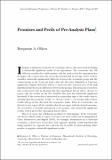| dc.contributor.author | Olken, Benjamin A. | |
| dc.date.accessioned | 2016-08-30T18:32:13Z | |
| dc.date.available | 2016-08-30T18:32:13Z | |
| dc.date.issued | 2015-08 | |
| dc.identifier.issn | 0895-3309 | |
| dc.identifier.uri | http://hdl.handle.net/1721.1/104069 | |
| dc.description.abstract | Imagine a nefarious researcher in economics who is only interested in finding a statistically significant result of an experiment. The researcher has 100 different variables he could examine, and the truth is that the experiment has no impact. By construction, the researcher should find an average of five of these variables statistically significantly different between the treatment group and the control group at the 5 percent level—after all, the exact definition of 5 percent significance implies that there will be a 5 percent false rejection rate of the null hypothesis that there is no difference between the groups. The nefarious researcher, who is interested only in showing that this experiment has an effect, chooses to report only the results on the five variables that pass the statistically significant threshold. If the researcher is interested in a particular sign of the result—that is, showing that this program “works” or “doesn’t work”— on average half of these results will go in the direction the researcher wants. Thus, if a researcher can discard or not report all the variables that do not agree with his desired outcome, the researcher is virtually guaranteed a few positive and statistically significant results, even if in fact the experiment has no effect. | en_US |
| dc.language.iso | en_US | |
| dc.publisher | American Economic Association (AEA) | en_US |
| dc.relation.isversionof | http://dx.doi.org/10.1257/jep.29.3.61 | en_US |
| dc.rights | Article is made available in accordance with the publisher's policy and may be subject to US copyright law. Please refer to the publisher's site for terms of use. | en_US |
| dc.source | American Economic Association | en_US |
| dc.title | Promises and Perils of Pre-Analysis Plans | en_US |
| dc.type | Article | en_US |
| dc.identifier.citation | Olken, Benjamin A. “ Promises and Perils of Pre-Analysis Plans.” Journal of Economic Perspectives 29, no. 3 (August 2015): 61-80. © 2016 American Economic Association. | en_US |
| dc.contributor.department | Massachusetts Institute of Technology. Department of Economics | en_US |
| dc.contributor.mitauthor | Olken, Benjamin A. | en_US |
| dc.relation.journal | Journal of Economic Perspectives | en_US |
| dc.eprint.version | Final published version | en_US |
| dc.type.uri | http://purl.org/eprint/type/JournalArticle | en_US |
| eprint.status | http://purl.org/eprint/status/PeerReviewed | en_US |
| dspace.embargo.terms | N | en_US |
| dc.identifier.orcid | https://orcid.org/0000-0003-1918-4631 | |
| mit.license | PUBLISHER_POLICY | en_US |
